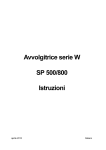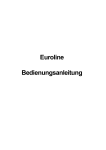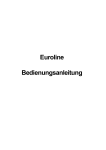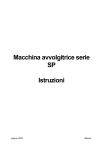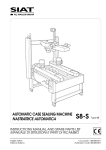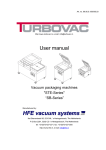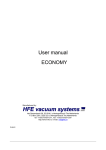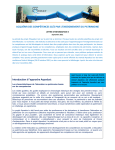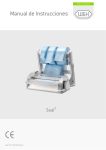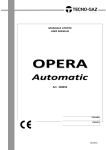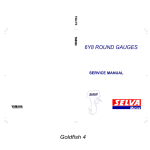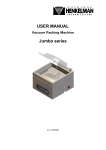Download Euroline Istruzioni
Transcript
Euroline Istruzioni Istruzioni per l’uso Istruzioni per l’uso Per garantire la sicurezza del personale addetto al funzionamento e alla manutenzione durante l’utilizzo dei macchinari FAS, è essenziale istruire il personale su come utilizzare il presente manuale. Il manuale si compone di tre parti: Parte prima Contiene istruzioni relative alla sicurezza e informazioni sulla responsabilità. Il personale addetto all’utilizzo di questa macchina è tenuto a leggere e a comprendere questa parte. Parte seconda Contiene istruzioni su come utilizzare la macchina. Questa parte deve essere a disposizione degli operatori. Parte terza Fornisce istruzioni relative a manutenzione, impostazioni e regolazioni. Questa parte, disponibile solo in lingua inglese, è riservata al personale addetto alla manutenzione e ai responsabili dei settori produttivo/ operativo. La macchina viene consegnata unitamente a un manuale completo, comprendente tutte le tre parti. Per l’acquisto di manuali o parti supplementari, rivolgersi a: FAS Converting Machinery AB / Service department Telefono: +46 411 692 60. Service telefono +46 411 69298 Fax: +46 411 127 40. Email: [email protected]. giugno 2014 Euroline ii Istruzioni per l’uso Indice Istruzioni per l’uso Parte prima Istruzioni relative alla sicurezza e alla responsabilità Istruzioni relative alla sicurezza e alla responsabilità Responsabilità . . . . . . . . . . . . . . . . . . . . . . . . . . . . . . . . . . . . 2 Informazioni relative alla salute e alla sicurezza Precauzioni di sicurezza Sicurezza Parte seconda Manuale di istruzioni Installazione Interblocco . . . . . . . . . . . . . . . . . . . . . . . . . . . . . . . . . . . . . . . 8 Quadro operatore Quadro indicatori . . . . . . . . . . . . . . . . . . . . . . . . . . . . . . . . . . 9 Utilizzo del quadro di comando. . . . . . . . . . . . . . . . . . . . . . 10 Menu del quadro di comando Menu principale . . . . . . . . . . . . . . . . . . . . . . . . . . . . . . . . . . 11 Menu impostazioni SP (F1) . . . . . . . . . . . . . . . . . . . . . . . . . 12 Menu Tape (F4) . . . . . . . . . . . . . . . . . . . . . . . . . . . . . . . . . . 13 Menu impostazioni BM (F2) . . . . . . . . . . . . . . . . . . . . . . . . 14 Menu Tensione BM (F5) . . . . . . . . . . . . . . . . . . . . . . . . . . . 15 Struttura dei menu Avviamento e funzionamento Prima dell'avviamento . . . . . . . . . . . . . . . . . . . . . . . . . . . . . 17 Avviamento Inserimento del nastro nell'unità SP . . . . . . . . . . . . . . . . . . 23 Spegnimento della macchina Spegnimento programmato . . . . . . . . . . . . . . . . . . . . . . . . . 25 Spegnimento di emergenza . . . . . . . . . . . . . . . . . . . . . . . . . 25 Arresto automatico. . . . . . . . . . . . . . . . . . . . . . . . . . . . . . . . 25 Part Three Settings and adjustment Service Settings and adjustment Preheat settings for Off-line production . . . . . . . . . . . . . . . CF-unit Chain tension . . . . . . . . . . . . . . . . . . . . . . . . . . . . . . . . . . . . Checking timing belt tension . . . . . . . . . . . . . . . . . . . . . . . . Checking the variator belt . . . . . . . . . . . . . . . . . . . . . . . . . . Changing knives . . . . . . . . . . . . . . . . . . . . . . . . . . . . . . . . . Changing the seal wire. . . . . . . . . . . . . . . . . . . . . . . . . . . . . Changing the brushes on the sealing bars . . . . . . . . . . . . . . Servo motors . . . . . . . . . . . . . . . . . . . . . . . . . . . . . . . . . . . . giugno 2014 Euroline 28 30 33 35 36 37 39 41 iii Istruzioni per l’uso Setting of grippers . . . . . . . . . . . . . . . . . . . . . . . . . . . . . . . . Checking of belt tension, drive motor . . . . . . . . . . . . . . . . . Setting of fingers in horizontal position . . . . . . . . . . . . . . . Adjusting the high speed nip . . . . . . . . . . . . . . . . . . . . . . . . Changing the nip bars from reverse to standard setting. . . . Lubrication instructions CF-unit . . . . . . . . . . . . . . . . . . . . . . . . . . . . . . . . . . . . . . . . . Lubricants . . . . . . . . . . . . . . . . . . . . . . . . . . . . . . . . . . . . . . SP-unit . . . . . . . . . . . . . . . . . . . . . . . . . . . . . . . . . . . . . . . . . Alarm list Fault tracing SP-unit . . . . . . . . . . . . . . . . . . . . . . . . . . . . . . . . . . . . . . . . . giugno 2014 Euroline 42 43 43 43 44 45 45 46 49 iv Euroline Parte prima Istruzioni relative alla sicurezza e alla responsabilità Marzo 2007 Istruzioni relative alla sicurezza e alla responsabilità Istruzioni relative alla sicurezza e alla responsabilità Responsabilità La Eurolineè stata progettata per la perforazione, sigillatura e avvolgimento di sacchetti di plastica in rotolo di pellicola in polietilene. È vietato qualsiasi altro impiego che preveda l’avvolgimento di altri materiali, salvo previa autorizzazione di FAS Converting Machinery AB. FAS Converting Machinery AB non potrà essere ritenuta responsabile per danni o infortuni provocati da modifiche apportate al macchinario. FAS Converting Machinery AB non potrà essere ritenuta responsabile qualora la macchina venga modificata o utilizzata in modo diverso da quanto previsto nelle istruzioni o specifiche del produttore. FAS Converting Machinery AB non si assume alcuna responsabilità in caso di mancata consegna dei manuali al personale incaricato. Tutte le macchine di FAS Converting Machinery AB sono corredate da manuali di istruzioni. È responsabilità dei clienti accertarsi che il personale abbia libero accesso al presente manuale. È responsabilità dei clienti istruire adeguatamente gli operatori sul funzionamento e sulla manutenzione del macchinario FAS in condizioni di sicurezza, evitando in questo modo qualsiasi incidente. giugno 2014 Euroline 2 Informazioni relative alla salute e alla sicurezza Informazioni relative alla salute e alla sicurezza Il presente documento contiene importanti informazioni sui pericoli. Tali informazioni sono rappresentate dalle indicazioni di Pericolo, Avvertenza e Attenzione, contenute nel presente capitolo. La comparsa di un simbolo di avvertenza in qualsiasi punto del presente manuale significa che, prima di procedere, è necessario consultare l’apposita indicazione di Pericolo o Avvertenza all’interno del presente capitolo. Il simbolo di Avvertenza è il seguente: ! Prima di mettere in funzione la macchina, leggere attentamente il presente capitolo e prestare particolare attenzione alle indicazioni di Pericolo, Avvertenza e Attenzione. Il mancato rispetto di queste indicazioni, può causare gravi infortuni al personale o danni all’attrezzatura. Il personale incaricato del funzionamento e della manutenzione della macchina dovrà essere adeguatamente addestrato sul funzionamento della macchina e prendere dimestichezza con le modalità di funzionamento. ! ! Pericolo Pericolo immediato per la vita! La mancata osservanza di questa informazione metterà in pericolo la vostra vita! Ogni INDICAZIONE DI PERICOLO stabilisce nello specifico la natura di un determinato pericolo e il modo in cui questo può essere evitato. Le INDICAZIONI DI PERICOLO sono riportate nello stesso stile di questa indicazione. Avvertenza Rischio di gravi infortuni! La mancata osservanza di questa informazione potrebbe provocare gravi lesioni al personale! Ogni INDICAZIONE DI AVVERTENZA stabilisce nello specifico la natura di un determinato pericolo e il modo in cui questo può essere evitato. Le INDICAZIONI DI AVVERTENZA sono riportate nello stesso stile di questa indicazione. Cautela giugno 2014 Rischio di lesioni di minore entità o danno all’attrezzatura! La mancata osservanza di questa informazione può provocare lesioni di minore entità o danni all’attrezzatura! Ogni indicazione di Attenzione stabilisce nello specifico la natura di un determinato pericolo e il modo in cui questo può essere evitato. Le indicazioni di Attenzione sono riportate nello stesso stile di questa indicazione. Euroline 3 Precauzioni di sicurezza Precauzioni di sicurezza ! Pericolo Questa macchina è alimentata da corrente elettrica di rete e pertanto, quando è accesa, al suo interno sono presenti tensioni letali. Il personale deve procedere con la massima cautela quando opera in prossimità della macchina e i coperchi, i pannelli o i ripari sono smontati. ! Avvertenza La macchina contiene parti in movimento e presenta dunque un rischio di lesioni quando i ripari fissi della macchina sono smontati. Le regolazioni sulla macchina vanno eseguite esclusivamente da personale autorizzato, che deve procedere sempre con estrema cautela. ! Avvertenza Il personale che opera in prossimità della macchina deve prestare particolare attenzione a indumenti, guanti e capelli lunghi. Tutti gli operatori con i capelli lunghi dovranno sempre indossare una retina per capelli. Gli operatori non devono indossare guanti o abiti ampi. Cautela Durante la manipolazione della pellicola in plastica può prodursi elettricità statica. Particolari avvertenze per l'unità CF ! Avvertenza Le lame dell'unità CF sono affilate. Per evitare il rischio di infortuni, il personale deve procedere con la massima cautela quando maneggia le lame della perforatrice. ! Avvertenza Il ballerino si sta muovendo in verticale. Per evitare il rischio di infortuni, tenere sempre lontane le mani dal ballerino mentre questo è in movimento. giugno 2014 Euroline 4 Precauzioni di sicurezza Particolari avvertenze per l'unità SP ! Avvertenza Il ballerino si sta muovendo in verticale. Per evitare il rischio di infortuni, tenere sempre lontane le mani dal ballerino mentre questo è in movimento. ! Avvertenza La macchina si fermerà in posizione di stand-by se la macchina per sacchetti viene arrestata. La Euroline comincerà automaticamente a ruotare non appena l'unità CF inizia a funzionare. Vi è rischio di lesioni dovute agli alberi in movimento. ! Avvertenza Il ballerino si sta muovendo in verticale. Tenere sempre lontane le mani dal ballerino mentre questo è in movimento. Quando la pellicola avanza nella macchina, assicurarsi che il ballerino sia in posizione sollevata. Se il nastro frena, il ballerino si abbasserà ad alta velocità. Vi è rischio di lesioni dovute a schiacciamento. ! Avvertenza Durante il cambio rotolo, i perni di presa fuoriescono e ruotano ad alta velocità. Vi è rischio di lesioni del personale dovute a schiacciamento. ! Avvertenza Nell’area della testina di scintillamento è presente alta tensione. Tenere sempre lontane le mani da quest’area quando la scintilla è impostata su "ON". giugno 2014 Euroline 5 Sicurezza Sicurezza Per garantire la sicurezza dell’operatore, la macchina è dotata sia di ripari fissi che di ripari apribili. La macchina è dotata di due pulsanti di arresto di emergenza, la cui posizione è illustrata nella figura seguente. 5 6 1 Avvertenza, alta tensione 2 Avvertenza, alberi rotanti 3 Marchio CE 4 Arresto di emergenza 5 Avvertenza, schiacciamento 6 Avvertenza, barre di sigillatura calde 7 Interruttore di sicurezza 4 4 4 5 3 7 2 4 1 7 7 7 Fig. 1 Etichette e interruttori di sicurezza Quando più macchine vengono collegate in linea, l’azionamento del pulsante di arresto di emergenza, o l’apertura di un qualsiasi riparo o di una qualsiasi macchina collegata in serie, provocherà l’arresto completo di tutte le macchine della linea. Vedere “Spegnimento di emergenza” a pagina 25, per il collegamento. I ripari fissi non devono in nessun caso essere rimossi dalla macchina durante la fase di produzione. Gli interruttori di sicurezza non devono essere manomessi allo scopo di bypassare i dispositivi di interblocco di sicurezza, rendendo così possibile l’apertura dei ripari mentre la macchina è in produzione. Qualsiasi interruttore di sicurezza rotto o guasto va immediatamente sostituito. giugno 2014 Euroline 6 Euroline Parte seconda Manuale di istruzioni Febbraio 2011 Installazione Installazione La posizione della Euroline rispetto alle altre macchine della linea di produzione è riportata nella Fig. 1. Unità SP Estrusore oppure Svolgitore Unità CF Fig. 1 Installazione tipica La Euroline non va fissata in alcun modo, ma deve essere posizionata direttamente sul pavimento, dove può essere spostata e dove è facilmente accessibile per la manutenzione. Connessioni elettriche e raccordi per l’alimentazione di aria compressa sono presenti sulla parte inferiore della macchina. Per facilitare la manutenzione, i cavi elettrici e i tubi dell’aria possono essere sospesi dal soffitto e fissati per mezzo di connettori a sgancio rapido. Connessione elettrica, standard: 400 V, 50 Hz, trifase, neutro e massa. Portata fusibili: 16 A Pressione necessaria aria compressa:6 bar Consumo d’aria: 18 litri per cambio rotolo Interblocco La macchina può essere interbloccata, per garantire l’arresto automatico di tutte le macchine della linea di produzione in caso di guasto a una qualsiasi delle macchine stesse. Il cavo di interblocco è fornito con la macchina. Se non si utilizza il sistema d’interblocco, occorre inserire nell’interblocco uno speciale connettore che consente il funzionamento della macchina. Vedere “Arresto automatico” a pagina 25 per l’interconnessione delle macchine. giugno 2014 Euroline 8 Quadro operatore Quadro operatore EUROLINE 1 Quadro di comando 2 Indicatore di potenza della scintilla 3 Manopola di regolazione della potenza della scintilla 4 Selettore di modalità Posizione sinistra Accumulatore in alto, scintilla disattiva Posizione centrale Accumulatore in basso, scintilla disattiva Posizione destra Accumulatore in basso, scintilla attiva 5 Potenziometro di velocità macchina 6 Pulsante di avviamento macchina (utilizzato anche per il cambio rotolo manuale). 7 1 F1 F2 F3 F4 F5 F6 2 6 4 Pulsante di arresto macchina (utilizzato anche la ritrazione dei perni di presa). 3 5 7 Fig. 2 Quadro operatore Quadro indicatori 1 Accumulatore riduzione velocità regolazione verso l'alto 2 Accumulatore riduzione velocità regolazione verso il basso 1 2 Fig. 3 Quadro indicatori giugno 2014 Euroline 9 Quadro operatore Utilizzo del quadro di comando Il quadro di comando dispone di un display incorporato che visualizza cinque videate diverse: il Menu principale e quattro sottomenu. È possibile visualizzare ciascuna videata premendo il tasto funzione corrispondente, cioè Menu principale o F1-F4. Le diverse videate presentano i parametri letti da o immessi nel sistema PLC della Euroline. Alcuni parametri possono essere facilmente modificati procedendo nel modo seguente: 1 Premere il tasto funzione corrispondente (Menu principale o F1-F4). 2 Usare i quattro tasti freccia (rossi) per passare al parametro da modificare. In alcuni menu, occorre utilizzare i tasti freccia giù (o su) per visualizzare tutte le righe. 3 Fig. 4 Quadro di comando Immettere il nuovo valore usando i tasti numerici, quindi premere Invio (tasto con anello rosso). Se il parametro è di tipo a selezione alternativa (ad es. On/Off), utilizzare il tasto Invio per passare da un’alternativa all’altra. giugno 2014 Euroline 10 Menu del quadro di comando Menu del quadro di comando Menu principale Selezionare Menu principale premendo il rispettivo pulsante (1) Il menu principale viene visualizzato anche dopo circa 30 secondi nel caso in cui non venga premuto nessun altro tasto. Bags (Sacchetti) Imposta il numero di sacchetti da produrre per un rotolo. Cnt (Conteggio) Mostra il numero di sacchetti nel rotolo che si sta formando. Il cambio rotolo avviene quando il numero del contatore corrisponde a quello preimpostato ("Bags" [Sacchetti]). SealsetSeal1 Mostra la percentuale di uscita di corrente max di sigillatura Seal1 Mostra la corrente attuale nel filo di sigillatura in sealbar #1, che ha un filo con sezione di 1,65 mm Fig. 5 Pulsante del menu principale Bags 12 Cnt 06 Sealset Seal1 4.0A 42% Seal2 4.0A Speed 50 m/min Fig. 6 Menu principale Seal2 Mostra la corrente attuale nel filo di sigillatura in sealbar #2, che ha un filo con sezione di 5 mm. La potenza di sigillatura può essere modificata inserendo un valore diverso nel campo percentuale "Sealset". Utilizzare i tasti freccia per selezionare il campo e inserire un nuovo valore usando il tastierino numerico. Speed (Velocità) Visualizza la velocità attuale della macchina. Per modificare la velocità, con la macchina in funzionamento fuori linea, ruotare il potenziometro della velocità sul quadro operatore. Se in modalità in linea, il potenziometro deve essere sulla posizione massima. giugno 2014 Euroline 11 Menu del quadro di comando Menu impostazioni SP (F1) Perf Pos set# (Pos. di perf. imp. nr.) Per l’impostazione manuale della posizione della perforazione. Per potere eseguire l’impostazione manuale, "set" (vedere "Submenu Auto perf set", di seguito) deve essere impostato su OFF. set# (imp. nr.) Regola automaticamente la posizione della perforzazione. Effettuare la selezione usando i tasti freccia, quindi premere Invio per selezionare Submenu Auto perf set sottostante. Perf Pos 875 set# Tearoff Speed 3 Tearoff 10 laps Open-grippers 2 laps Stop-ofline on Direction CCW Fig. 7 Menu F1, Menu impostazioni SP Tearoff Speed (Velocità strappo) Imposta la velocità dei perni di presa durante la fase di strappo. Sono preimpostate tre velocità: 1-bassa, 2-media e 3-alta. Tearoff - laps (Strappo - sovrapposizioni) Impostare il numero di sovrapposizioni alla velocità di strappo durante la fase di strappo. Open-grippers 2 laps (Apertura pinze 2 sovrapposizioni) Impostare il numero di sovrapposizione dei perni di presa prima dell'apertura delle pinze dopo il cambio rotolo. Stop-ofline (Arresto - fuori linea) Se impostato su "on", l'intera linea si arresterà quando si verifica un errore; se impostato su "off" si arresterà solo l'unità SP quando si verifica un errore nell'unità stessa. Auto set perf Direction #-(Direzione #--) Senso di rotazione dei perni di presa, orario o antiorario. 0 - 15 off m/min #--- 15 - 30 m/min #--- 30 - 50 m/min #--- Submenu Auto perf set 50 - 70 m/min #--- Auto set perf (Imp. autom perf.) Contiene i valori preimpostati di Perf. Position (Posizione perforazione). Utilizzato dalla macchina quando l'opzione Auto set perf. è abilitata. 70 - 90 m/min #--- giugno 2014 Euroline 90 - m/min #--- Fig. 8 Sottomenu F1, Menu Contatore, "Auto perf set" 12 Menu del quadro di comando Menu Tape (F4) Tape (Nastro) Impostare su ON per attivare la nastratrice, in caso contrario impostare su OFF. Start Tape - Bags (Avvio nastro - Sacchetti) Segnale di avvio per il nastro prodotto dopo un numero preimpostato di sacchetti prima del cambio rotolo. Tape 500 Start Tape 2 Bags Start Tape 0 pls Fig. 9 Menu F4, Menu Tape Start Tape -- pls (Avvio nastro -- impulsi) Il nastro viene alimentato per il numero di impulsi impostato dopo l'emissione del segnale di avvio. Questa caratteristica è usata per la regolazione fine della lavorazione del nastro. giugno 2014 Euroline 13 Menu del quadro di comando Menu impostazioni BM (F2) Servo (Servosistema) Attiva / disattiva (ON/OFF) la funzione di perforazione e Servo ON sigillatura (movimento), ad esempio disattiva tutti i Length 600 mm servosistemi. Skirt 20 Length - mm (Lunghezza - mm) Imposta la lunghezza desiderata del sacchetto, ovvero la Knife Servo ON distanza fra due perforazioni. Seal Servo ON Skirt (Orlo) Imposta la lunghezza dell’orlo, cioè la distanza fra la sigillatura e la perforazione. Il valore mostrato è fittizio. Tuttavia una modifica ad esempio di 10 unità di questo valore determina uno spostamento di 10 millimetri nella posizione di sigillatura. Auto Seal ON Min Seal Speed 30 Seal Alarm 1 3.8A Seal Alarm 2 3.8A Fig. 10 Menu F2 Impostazioni CF Knife Servo (Servosistema lame) Attiva/disattiva (ON/OFF) il servosistema delle lame, ad esempio la perforazione è disabilitata se il servosistema delle lame è disattivato. Seal Servo (Servosistema sigillatura) Attiva/disattiva (ON/OFF) il servosistema della sigillatura, ad esempio la perforazione è disabilitata se il servosistema della sigillatura è disattivato. Auto Seal (Sigillatura automatica) Se impostato su ON, è necessaria una velocità minima della macchina per attivare la potenza di sigillatura. Min Seal Speed (Velocità di sigillatura min.) Se è attivata l'opzione "Auto Seal", il valore su questa linea imposta la velocità minima che rende possibile la sigillatura. Se la velocità scende al di sotto del valore impostato, la sigillatura viene interrotta per evitare rotture del nastro Seal Alarm 1 (Allarme 2 Sigillatura) Imposta il livello di corrente minima di sigillatura, prima che scatti l’allarme. Il livello va impostato a circa l’80% della corrente assorbita per la sigillatura del sacchetto. Seal Alarm 2 (Allarme 2 Sigillatura) Imposta il livello di corrente minima di sigillatura, prima che scatti l’allarme. Il livello va impostato a circa l’80% della corrente assorbita per la sigillatura del sacchetto. giugno 2014 Euroline 14 Menu del quadro di comando Menu Tensione BM (F5) Scale Factor #---(Fattore di scala #----) Impostato dal costruttore su 2,525 - NON modificare. + Tension - Scale Factor 2.525 + Tension - Fig. 11 Menu F5, Tensione CF (+ Tensione -) Utilizzare F2 e F4 per aumentare o ridurre la tensione del nastro. giugno 2014 Euroline 15 Struttura dei menu Struttura dei menu Menu principale Bags 12 Cnt 06 Sealset Seal1 4.0A 42% Seal2 4.0A Speed 50 m/min Settings (Impostazioni) Tape 500 Start Tape 2 Bags Start Tape 0 pls giugno 2014 SP SP Perf Pos 875 set# Tearoff Speed 3 Tearoff 10 laps Open-grippers 2 laps Stop-ofline on Direction CCW Auto set perf 0 - 15 m/min 15 - 30 m/min 30 - 50 m/min 50 - 70 m/min 70 - 90 m/min 90 m/min TAPE (NASTRO) Timing (Diagramma dei tempi) Delay tearoff Finger pos Nip down Fingers in Start delay Nip up Default #-#-#-#-#-#-#-- #-#--#--#--#--#--#--- Settings (Impostazioni) Tension (Tensione) BM BM Servo ON Length 600 mm Skirt 20 Knife Servo ON Seal Servo ON Auto Seal ON Min Seal Speed 30 Seal Alarm 1 3.8A Seal Alarm 2 3.8A Euroline s s s s s s Scale Factor #---(Fattore di scala #----) + Tension (+ Tensione -) 16 Avviamento e funzionamento Avviamento e funzionamento Prima dell'avviamento Sull'unità SP 1 1 Collocare un numero idoneo di pesi sul ballerino, come mostrato nella Fig. 12. Fissarli per mezzo di viti su entrambi i lati. Il numero esatto viene determinato durante il funzionamento (pellicola sottile – peso minore). Fig. 12 Posizionamento dei pesi 2 Regolare verso l'alto la pressione dell'accumulatore riduzione velocità 3 Regolare verso il basso la pressione dell'accumulatore riduzione velocità 2 3 Fig. 13 Regolare le pressioni 4 4 Regolare la distanza tra le piastre dei perni di presa ruotando le manopole, vedere la Fig. 14. La distanza deve essere: larghezza del nastro (B) più 20-25 mm. su ciascun lato. Le due piastre dei perni devono trovarsi alla stessa distanza dall’asse centrale della macchina. 4 Fig. 14 Regolare la distanza giugno 2014 Euroline 17 Avviamento e funzionamento 5 Regolare l’elettrodo del contatore a scintilla in modo che la distanza tra elettrodo e asta sia di circa 2 mm. Fare riferimento alla Fig. 15. 5 Fig. 15 Regolare il contatore a scintilla Sull'unità SP 6 Impostare il rullo ballerino nel modo seguente: a Produzione in linea e fuori linea con rullo di compressione condotto. Non vi sono fermi. b Produzione fuori linea, senza rullo di compressione condotto. Utilizzando i due fermi, bloccare il rullo ballerino nella posizione più bassa. I fermi devono essere ordinati separatamente. 6 Fig. 16 Impostare il rullo ballerino 7 Portare l’interruttore principale in posizione ON. 7 Fig. 17 Portare l’interruttore principale su ON giugno 2014 Euroline 18 Avviamento e funzionamento 8 Sollevare l’accumulatore portando il selettore di modalità in posizione sinistra. 8 Fig. 18 Sollevare l’accumulatore 9 Dal menu principale del quadro di comando, preimpostare il numero desiderato di sacchetti per rotolo e gli altri parametri. Bags 12 Cnt 06 Sealset Seal1 4.0A 42% Seal2 4.0A Speed 50 m/min Fig. 19 Menu principale Impostazioni per l'unità SP 10 Dal menu F1 impostare i parametri per l'unità SP. Per ulteriori informazioni, vedere “Menu impostazioni SP (F1)” a pagina 12. Perf Pos 875 set# Tearoff Speed 3 Tearoff 10 laps Open-grippers 2 laps Stop-ofline on Direction CCW Fig. 20 Menu F1, Menu impostazioni SP Impostazioni per la nastratrice opzionale Se si utilizza la nastratrice, selezionare il menu F4 ed effettuare le impostazioni necessarie. Per ulteriori informazioni, vedere vedere “Menu Tape (F4)” a pagina 13. Tape 500 Start Tape 2 Bags Start Tape 0 pls Fig. 21 Menu F4, Menu impostazioni SP giugno 2014 Euroline 19 Avviamento e funzionamento Impostazioni per l'unità CF Servo 11 Dal menu F2 impostare i parametri per l'unità CF. Per ulteriori informazioni, vedere “Menu impostazioni BM (F2)” a pagina 14 ON Length 600 mm Skirt 20 Knife Servo ON Seal Servo ON Auto Seal ON Min Seal Speed 30 Seal Alarm 1 3.8A Seal Alarm 2 3.8A Fig. 22 Menu F2 12 Impostare il potenziometro di VELOCITÀ MACCHINA su 0. Fig. 23 Potenziometro di velocità macchina giugno 2014 Euroline 20 Avviamento Avviamento Inserimento del nastro nell'unità CF Il nastro deve essere ora inserito attraverso l'unità CF come mostrato nella Fig. 24. Assicurarsi che tra la macchina e l’estrusore o lo svolgitore sia presente la minor porzione possibile di pellicola. ! Pericolo! Questa macchina è alimentata da corrente elettrica di rete e pertanto, quando è accesa, al suo interno sono presenti tensioni letali. Il personale deve procedere con la massima cautela quando opera in prossimità della macchina e i coperchi, i pannelli o i ripari sono smontati. Fig. 24 Inserimento del nastro dallo svolgitore 1 Posizionare il rotolo sullo svolgitore. Fig. 25 2 Premere il pulsante JOG sul pannello per avviare lo svolgimento della pellicola dal rotolo sullo svolgitore. Tenere premuto il pulsante per quanto necessario perché la pellicola possa essere facilmente inserita nell'unità CF. Fig. 26 giugno 2014 Euroline 21 Avviamento 3 Afferrare quindi la pellicola e introdurla delicatamente nell'unità CF dopo aver premuto il pulsante JOG per fare avanzare lentamente lo svolgitore e l'unità CF. Assicurarsi che non vi siano grinze o pieghe quando la pellicola entra nel ballerino. 4 Tenere premuto il pulsante JOG fino a quando la pellicola non esce dall'altro lato dell'unità CF. Fig. 27 5 Portarsi all'altro lato dell'unità CF (tra l'unità CF e l'unità SP) e continuare a far avanzare la pellicola premendo il pulsante JOG che si trova su questo lato. 6 Continuare a far avanzare la pellicola, fino a quando la lunghezza è sufficiente per inserirla, tramite la stazione di piegatura (se presente), nell'unità SP. Fig. 28 Inserimento del nastro dall'estrusore 1 Afferrare la pellicola proveniente dall'estrusore e introdurla delicatamente nell'unità CF mentre si preme il pulsante JOG per fare avanzare lentamente l'unità CF. Assicurarsi che non vi siano grinze o pieghe quando la pellicola entra nel ballerino. 2 Tenere premuto il pulsante JOG fino a quando la pellicola non esce dall'altro lato dell'unità CF. Fig. 29 giugno 2014 Euroline 22 Avviamento 3 Portarsi all'altro lato dell'unità CF (tra l'unità CF e l'unità SP) e continuare a far avanzare la pellicola premendo il pulsante JOG che si trova su questo lato. 4 Continuare a far avanzare la pellicola, fino a quando la lunghezza è sufficiente per inserirla, tramite la stazione di piegatura (se presente), nell'unità SP. Inserimento del nastro nell'unità SP 1 Inserire il lato libero del nastro attraverso lo spazio tra i rulli di trascinamento nell’accumulatore. Fig. 31. 2 Inserire il nastro tra l’elettrodo (barra di scintilla) e l’asta. Fig. 30 3 Aprire il rullo di compressione ad alta velocità e inserire il nastro tra il rullo di compressione ad alta velocità e i rulli di supporto. Chiudere il rullo di compressione ad alta velocità. Fig. 31 Inserire il nastro 4 Tenendo il nastro con una mano, collocare il selettore di modalità in posizione intermedia per abbassare l’accumulatore. 5 Premere il pulsante di avviamento macchina. La luce del pulsante si accende e il motore dell’avvolgitrice entra in funziona. 6 ! Premere ancora una volta il pulsante di avviamento macchina, avverrà un cambio rotolo manuale. Aumentare la velocità per mezzo del potenziometro di velocità. 4 5 6 Fig. 32 Quadro operatore Avvertenza! Durante il cambio rotolo, i perni di presa fuoriescono e ruotano ad alta velocità. Vi è rischio di lesioni dovute a schiacciamento. giugno 2014 Euroline 23 Avviamento 7 8 9 Collocare il selettore di modalità in posizione destra per avviare la scintilla. 7 Regolare il potenziometro di potenza della scintilla per consentire al generatore di scintilla di fornire la potenza desiderata, in modo che possa avvenire il cambio rotolo automatico. Una tensione troppo bassa non consente l’attivazione del contatore; una tensione troppo alta può provocare una bruciatura del materiale. Se il rotolo diviene troppo grande, premere il pulsante di avviamento macchina per eseguire un cambio rotolo manuale. 8 9 Fig. 33 Quadro operatore Ruotare verso l’alto il potenziometro di velocità macchina in modo che il ballerino sia fermo in una posizione intermedia prima del successivo cambio rotolo. 10 Regolare con precisione le piastre dei perni di presa in modo che la distanza tra le piastre e il rotolo sia di 15 mm. su ciascun lato. Fig. 34 Regolare le piastre dei perni di presa giugno 2014 Euroline 24 Spegnimento della macchina Spegnimento della macchina Spegnimento programmato 1 1 Collocare il selettore di modalità in posizione intermedia per disattivare la scintilla. 2 Premere il pulsante di arresto macchina per fermare la macchina. 2 Spegnimento di emergenza La Euroline è dotata di 4 pulsanti rossi di arresto di emergenza. Se si preme uno di questi pulsanti, l’alimentazione viene interrotta e la macchina si ferma. Fig. 35 Quadro operatore Arresto automatico Le macchine possono essere collegate in modo interdipendente per consentire l’arresto di tutte le macchine della linea di produzione in caso di guasto in una di esse. Per attivare tale interblocco, impostare "Stop-ofline" (Arresto - fuori linea) su ON nel menu F1. giugno 2014 Euroline 25 Euroline Part Three Settings and adjustment Service June 2014 Settings and adjustment Settings and adjustment ! Warning! ! Warning! The Euroline machine contains moving parts and therefore there is a risk of personal injury when the machine guards are removed. Adjustments to the machine must be performed by authorised personnel only, who must exercise extreme caution at all times. Servicing/maintenance work must be performed by authorised personnel only, who must exercise extreme caution at all times to avoid the risk of personal injury. This machine operates from a mains electrical supply and therefore lethal voltages are present within the machine when it is switched on. All personnel must exercise extreme caution when in the vicinity of the machine with covers, panels or guards removed. June 2014 BW / U 900 27 Settings and adjustment Preheat settings for Off-line production The preheat function will reduce scrap after a master roll change or after a short production stop. Bags 12 Cnt 06 Sealset Seal1 4.0A 42% Seal2 4.0A Speed 50 m/min Fig. 1 The main menu Press F1. Perf Pos 875 Step down to "offline" and choose "on" set# Tearoff Speed 3 Tearoff 10 laps Open-grippers 2 laps Offline on Dancer/servo Direction CCW Fig. 2 Menu F1, Settings SP menu Press F4 for Pre heat settings. Hotmelt Step down to "Preheat settings" and enter the preheat settings menu. # Tape # Core #--- Twist Tie # CNT From Knife #--Preheat settings # Fig. 3 Menu F4 June 2014 BW / U 900 28 Settings and adjustment Set "preheat" to "on" Choose "Preheat level" in % of your production seal heat. This will be the heat that the seal bars will keep in standby while changing master roll or during a short production stop. (Initial setting 50%). Preheat on Preheat level #- % Preheat time #---s Sealheat delay #- s Choose "Preheat time" in seconds for standby duration. During this time the seal bars will be heated to the pre set level. (initial setting is 300 sec.) Choose "Seal heat delay" in seconds. When pushing the start button, the seal heat will go to 100%, and after the chosen seal heat delay the machine will start. Fig. 4 Sub menu from Preheat settings in menu F4 Activate Press F6 to activate the preheat. The F6 LED will flash. Note If the preheat time is exceeded during a stop, the preheat function has to be activated again by pressing F6. June 2014 BW / U 900 29 CF-unit CF-unit Chain tension Inside sealing section • The tension in the chains is correct when the sealing bar can be moved 10 mm outwards from its support. • Tighten the chain by loosening the screws in the lower bearing housing. Push the bearing housing downwards with a pinch bar, see Fig. 5. Tighten the screws for the bearing housing. Note Sealing bars should be engaged when chain tension is checked. Fig. 5 Inside cooling section • The tension in the chains is correct when the cooling bar can be moved 20 mm outwards from its support. • Tighten the chain by loosening the screws in the lower bearing housing. Push the bearing housing downwards with a pinch bar, see Fig. 6. Tighten the screws for the bearing housing. Fig. 6 June 2014 BW / U 900 30 CF-unit Outside sealing section The drive chains are governed by a resilient chain tensioner. See Fig. 7. Adjust the chain tension if so required by altering the spring tension with the help of the adjuster screw. Fig. 7 Outside cooling section The tension in the drive chains is automatically controlled by a sprocket on an arm, spring loaded in a clamping arm. With the correct tension in the chain, the arrow on the arm points at an angle of approx. 20° in relation to the clamping arm, see Fig. 9 Adjust the tension, if necessary, by loosening the screw on the rear and turning the clamping arm with a spanner (36 mm) until the correct tension is obtained. Tighten the screw. Fig. 8 Fig. 9 June 2014 BW / U 900 31 CF-unit Changing cup springs in chain tensioner .The chain tensioner for the sealing bar drive has cup springs inside. If there is no movement in the tensioner the cup springs must be replaced. • Remove the chain tensioner. Fig. 10 • Take out the adjustment screw. • Remove the lock screw. Moving part • Gently pull out the moving part • Pull out the stub shaft with cup springs. • Take off the cup springs from the stub shaft. • Clean the stub shaft and if necessary replace. Stub shaft Lock screw • Replace all cup springs and mount them as shown in Fig. 12. • Place the stub shaft with cup springs in the hole on the moving part. • Mount the fixed part. Cup springs Fixed part Adjustment screw • Mount the lock screw. • Mount the adjustment screw gently so it's not Fig. 11 pressing on the stub shaft. • Reassemble the chain tensioner and adjust the chain tension. See “Outside cooling section” on page 31. 9 package facing opposite 3 pcs = 1 package 27 pcs total Fig. 12 June 2014 BW / U 900 32 CF-unit Checking timing belt tension Nip roll timing belt The belt is correctly tensioned when it can be pushed down between the pulleys by 10 mm with a force of approx. 5 kp. • The timing belt for the nip roll drive is adjusted with a stretching screw, see Fig. 13. Note Safety bypass function must be activated to be able to operate the machine with open doors. The Nip switch must be set to the "close position" Fig. 13 Main motor timing belt The belt is correctly tensioned when it can be pushed down between the pulleys by 10 mm with a force of approx. 5 kp. • The timing belt from the motor is adjusted by loosening the screws which hold the motor, and moving the motor sideways, see Fig. 14. Note Excessive belt tension will damage the bearings. Fig. 14 June 2014 BW / U 900 33 CF-unit Servo motor timing belts In order to adjust the tension, the special tool supplied with the machine must be used. • To adjust belt tension, the support angle plate for servo motor is mowed sideways. Loosen the three hex-head bolts and move plate. The seal section drive has a set screw, the perforator drive has none. Proper tension is when belt can be pushed down 5 mm between pulleys. Tighten the three hex-head bolts again. Fig. 15 Fig. 16 ! June 2014 BW / U 900 Warning! The knives in the bag machine have sharp edges. To avoid the risk of personnel injury, all personnel must exercise extreme caution when handling the perforator blades. 34 CF-unit Checking the variator belt The variator belt should be tensioned to ensure that no slipping occurs during operation. Adjust the belt tension by moving the bearing housing with the tensioning screws. See Fig. 17. Note The belt must run straight between the belt pulleys and not lie against any of the bearings. Remark! Belt slip can also be caused by grease or oil on the variator belt pulley. Clean these and also the variator belt with a suitable cleaning and degreasing agent before tensioning the belt. Fig. 17 Shock absorber, dancing roller A hydraulic shock absorber for the lower end position is fitted on the dancing roller's bearing housing. • Check regularly to make sure that there is a gap of 1 mm between the point of the shock absorber and the shock absorber housing in order to achieve efficient shock absorbing. 1 mm • Adjust the gap by loosening the lock nuts and turning the adjuster screw. See Fig. 18 Fig. 18 June 2014 BW / U 900 35 CF-unit Changing knives 1 Remove all old knives. 2 Clean the knife holder and the new knives with degreasing agent. Grease the attaching screws with heat-resistant grease SKF LGHT 2. 3 Loosen the adjusting screws. 4 Fit new knives, cup springs and attaching screws. Tighten the screws by hand. Place the knife edge about 1-3 mm outside the working position. Rotate the knife holder one full-turn clockwise (opposite normal working direction) by hand so that the knives gets in correct position. Note 3 5 9 6 8 There must not be any web in the machine. 5 Use the adjustment screws, or a Fig. 19 screwdriver to move the knives approx. 0.5 mm outside the working position. Loosen the setscrews approx. 1 mm. 6 Tighten the attaching screws fully, then release by 20-30 degrees angle. 7 Rotate the knifeholder one full-turn clockwise (flow direction) by hand so that the knives fit in the correct position. 8 Tighten the attaching screws securely to ensure that the spring washers touch the bottom. 9 Tighten the adjusting screws so that they come into contact with the back of the knife. Test and re-adjust if necessary. 10 Grind nicks in the knives for perforation using a high-speed grinding machine. Use small, but close-lying nicks for thinner material and larger indents farther apart for thicker material. Fig. 20 shows an example on how to nick the lower gauge (10 mm pitch), resp. higher gauge (5 mm pitch). Perforator blades mounted on new machines, or supplied as spares, are always unnicked.. Fig. 20 11 Reassemble all guards after completion. June 2014 BW / U 900 36 CF-unit Changing the seal wire Note Seal wire Silicon rubber When exchanging the seal wire, teflon and silicon for new items, they must be exchanged on all sealing bars at the same time. Allen screw 1 Remove the sealing bars and place them on a table. 2 Peel off the teflon ribbon. The ribbon is Double sided tape Sealing bar fastened with double sided tape on the sides Fig. 21 Sealing bar with silicon rubber of the sealing bar. 3 Loosen the two allen screws and remove the old seal wire. Loosen the first screw carefully since the seal wire holders are spring loaded to keep the seal wire tensioned at all times. 4 5 Peel off the next teflon ribbon if using silicon rubber. This ribbon is also fastened with double sided tape on the sides of the sealing bar. Teflon ribbon Seal wire Seal ledge Allen screw Teflon ribbon Double sided tape Sealing bar Remove the silicon rubber or the seal ledge. Fig. 22 Sealing bar with seal ledge 6 Place a new silicon rubber or the seal ledge inside the aluminium bar. See Fig. 23. Fig. 23 Place silicon rubber/seal ledge 7 When using silicon rubber. Press firmly into groove/channel, chamfer each end at approx 45°. See Fig. 24. Fig. 24 Press silicon rubber/seal ledge June 2014 BW / U 900 37 CF-unit 8 Attach a new teflon ribbon over the silicon rubber. Replace the double sided tape if necessary. Note No teflon is needed under the sealwire if using seal leadge. Fig. 25 9 Put a new seal wire in place and fasten the allen screw. Fig. 26 10 Make sure that you press the seal wire holders towards each other when fastening the last screw, to keep the seal wire pretensioned. Fig. 27 11 Fasten the teflon ribbon with double sided tape. Fig. 28 June 2014 BW / U 900 38 CF-unit Changing the brushes on the sealing bars Seal wire holder • Remove the sealing bars and place them on a table. • Remove the screw and the U-shaped holder. • Gently pull out the old brush and disconnect the cable from the isolation plate. Brush • Insert a new brush and connect the cable to the isolation plate. • Place the U-shaped holder and fasten the screw. Do not overtighten. Screw U-shaped holder Screw Isolation plate Fig. 29 June 2014 BW / U 900 39 CF-unit Adjustment of sealing bar pressure 1 1 Loosen, but do not remove, the five bolts. 2 Use the two adjusting screws to adjust the pressure between the sealing bars, see Fig. 30. Make sure that both screws are adjusted equally in order to keep the sealing bars parallel with equal sealing pressure during the sealing process. 3 For factory settings, see Fig. 31. 4 Retighten the five bolts. 5 Repeat on other side. Note 2 3 Fig. 30 Adjust only on the two sideplates equipped with adjustment screws, (outfeed side of machine). B XXXX E27 B XXXX E19 Sealing bar Pressure 30 mm 22 mm Cooling bar Pressure 22 mm 22 mm Fig. 31 Adjustment of cooling bar pressure 1 Loosen, but do not remove, the three bolts. 2 Use a pinch bar to adjust the pressure between the upper part of cooling bars, see Fig. 32. 3 For factory settings, see Fig. 31. 4 Retighten one of the bolts. 5 Loosen, but do not remove, the three bolts. 6 Use a pinch bar to adjust the pressure between the lower part of cooling bars, see Fig. 32. Adjusted equally as on upper part in order to keep the cooling bars parallel with equal pressure. 7 Retighten the bolts. 8 Repeat on the other side of the machine. Note Adjust only on the two sideplates located on the outfeed side of machine. June 2014 3 1 5 Fig. 32 BW / U 900 40 CF-unit Servo motors The machine have two servo motors. One controls perforation and one controls sealing bars. Position finding is made by a sensor and corresponding flag. For location see Fig. 33. Perforation home position is fixed. For adjustment of sealing bar home position follow instructions below. Adjusting the sealing bar Home position Perforation sensor Sealing bar sensor Fig. 33 1 1 Loosen the upper sprocket of the sealing bars. Pry off the sprocket with a pinch bar (tight fit) until the sprocket and chain is movable in the direction of web motion. See Fig. 34. 2 Move the sealbars so they are horisontaly in line, see Fig. 35 3 To obtain correct stop position, check position of drive sprocket. The angle between sensor and sensor plate should be Fig. 34 120 degrees, see Fig. 36, corresponding to 14, 10 or 7 teeth on the sprocket, depending of machine type, see table below. 4 Firmly tighten diametrically opposed sprocket screws. 5 Reassemble all guards on completion. 1 2 Fig. 35 Machine type Fig. 36 June 2014 No. of teeth in 120° CF xxx/42 14 CF xxx/30 10 CF MINI 7 BW / U 900 41 CF-unit Setting of grippers 1 Set the grippers so that they can take up the web straight under the idler roller and opposite the centre of rotation of the fingers. Fig. 37. 1 Idler roller 2 Gripper 3 Fingers 3 2 2 Adjust by means of the stretch screws. Fig. 38. Fig. 37 Setting of grippers Fig. 38 Stretch screw June 2014 BW / U 900 42 CF-unit Checking of belt tension, drive motor The belt is correctly tensioned when it can be pressed down 3-5 cm between the belt pulleys. Adjust the belt tension by loosening the motor's attaching screws and moving the motor. Refer to Fig. 39. Fig. 39 Belt tension drive motor Setting of fingers in horizontal position The horizontal positioning of the web catching fingers is set as follows: 1 Set the main switch to the ON position. 2 Set the "mode selector" to the left position to lift the dancer up. 3 Press the "start machine" button twice to make a mnual roll change. Check to make sure that the fingers start to function and are in the correct position (the grooves shall be in "web flow" direction). To adjust, loosen the screws holding the fingers, turn the fingers and re-tighten the screws. 2 3 Fig. 40 Operating panel Adjusting the high speed nip The high speed up is adjusted with the knob, see Fig. 41. Fig. 41 Adjusting of high speed nip June 2014 BW / U 900 43 CF-unit Changing the nip bars from reverse to standard setting When running in reverse (menu choice DIRECTION REVERSE in menu F5), the metal bar and the rubber bar has to be interchanged. This procedure dscribes how the nip bars is changed from reverse back to normal. Proceed as follows: 1 Loosen both handles on the shaft. See Fig. 42 (Note! reverse mounting is shown) Fig. 42 Loosen the handles 2 Loosen the screws holding the bar to the axle, remove the bar and withdraw the axle. See Fig. 44 3 Turn the axle 180° and insert it again. Fig. 43 Loosen the screws holding the bar 4 Loosen the screws for the fixed bar and move the bar to the axle. Note that the bar now is positioned “upside-down”. 5 Take the bar removed in item 2 and mount it on the fixed bar’s position. Fasten the screws and tighten. 6 Mount back both handles. Fig. 44 Loosen the bar and withdraw the axle June 2014 BW / U 900 44 Lubrication instructions Lubrication instructions CF-unit Pos Lubrication point Lubricant Interval 1 Bearing, knife holder Grease Every week 2 Chains Chain grease Every week 3 Guides, dancing roller bearing Thin oil Every week 4 Bearing, variator Grease Every 6 month Table 1: Lubrication points Lubricants Bearings:SKF LGHT 2 or equivalent Chains: BEL-RAY CHAINLUBE with MOLYPHOS 1 3 2 4 2 Fig. 45 Lubrication points on CF-unit June 2014 BW / U 900 45 Lubrication instructions SP-unit Pos Point of lubrication Lubricant Interval 1 Bearings, grippers Motor oil Once a week 2 Linear bushing, accumulator Paraffin oil or thin motor oil Once a week 3 Linear bushings, gripper arm boxes Paraffin oil or thin motor oil Once a week 4 Shafts, guides Motor oil When necessary Table 2: 4 2 5 1 Fig. 46 Lubrication points on SP-unit June 2014 BW / U 900 46 Alarm list Alarm list Alarm Cause Dancer down stop The machine has stopped because dancing roller is at its lowest position, (provided Dancer down stop is set to ON in menu F4). Sealalarm stop The machine has stopped due to a seal alarm, (provided Sealalarm stop is set to ON in Menu F4) Seal alarm 1 There is a short circuit or break in the circuit for seal 1. To discontinue press the blue reset button on the Omron Power Controller A6. The machine will stop if Sealalarm stop is set to ON in Menu F4. Seal alarm 2 There is a short circuit or break in the circuit for seal 2. To discontinue press the blue reset button on the Omron Power Controller A7. The machine will stop if Sealalarm stop is set to ON in Menu F4. Low current seal 1 The current has decreased below the preset alarm level which is set in menu F3. The machine will stop if Sealalarm stop is set to ON in Menu F4. Low current seal 2 The current has decreased below the preset alarm level which is set in menu F3. The machine will stop if Sealalarm stop is set to ON in Menu F4. Nip open The nip is open during operation. Close the nip using the nip switch on the control panel. Safety bypassed The safety bypass keyswitch is set to "hand" during operation. No sealing The seal has not been activated within 30 seconds after production starts or, if sealing is deactivated, during production. Over current trip The current consumption has exceeded the limit. Check the frequency controller, the contactors F1 for main motor and F2 for servo drive. Turn off the main power before resetting the fuse F2 Dancer down The dancing roller is at its lowest position, (provided Dancer down stop is set to ON in menu F4). Ext stop order The machine has stopped due to an external stop order from an interlocked equipment. Photo cell The photo cell misses a number of marks which exceeds the number set in NBR OF MARKS in display F2. On restart the photocell must detect at least one print before normal operation. Perf heat The temperature in the perforator has exceeded the preset limit value. Table 3: June 2014 BW / U 900 47 Fault tracing Fault tracing CF-unit Fault Probable cause No seal or poor seal. Circuit breaker released. Reset the circuit breaker. Web tension in machine. Adjust the web tension in Web Tension menu. The variator belt slips. Clean the belt and variator with suitable degreasing agent. Possibly spray the belt with special spray. Tighten the variator belt. Check, and possibly change, the number of weights on the SPINNER dancing roller accumulator. Low pressure on the nip roller, it should be 3 bar. Pressure between cooling bars too low. Check by pulling a bag through the bars. See “Adjustment of cooling bar pressure” on page 40. Carbon brushes worn or make poor contact against the copper lines. Polish the carbon and copper lines with emery cloth. Possibly exchange the carbon for new item. Seal wire broken. Exchange the seal wire for new item. NOTE that when exchanging the seal wire, Teflon and silicon, must be replaced on all seal wires at the same time. Poor perforation. Perforating knives worn or incorrectly set. Sharpen the knives and reset them. They must not hit to hard against the anvil roller. Incorrect bag length. Incorrect bag length set. Check the setting. The shaft encoder on the variator gives the wrong number of pulses. Check to make sure that the shaft encoder is fitted securely on the variator. Shaft encoder damaged. Exchange the shaft encoder for new item. Machine runs unevenly and jerky. Dancing roller potentiometer or thyristor control faulty. Check the function. Servo motor not running. See separate instruction. Follow below instructions, fill in the paper form and contact FAS Converting Machinery AB Att. Service department. June 2014 Remedy measure BW / U 900 48 Fault tracing SP-unit Fault First bag in roll damaged Web tension too high. Pressure between grippers too high. Worn rubber and teflon on grippers. One of the valves not working. Perforation too strong. Remedy measure Adjust the weight of the dancing roll assembly. Reduce pressure. Replace rubber and/or teflon. Replace the air valve. Replace the knives in the Perforating Sealing Machine, smaller indent. Perforation does not stop in correct position for a change of roll Faulty function of pulse encoder. Replace pulse encoder. Wrong "Perf position" setting. Change setting in Parameter menu, . Fingers do not return to the horizontal position when changing roll Proximity switch not working, or distance to Adjust or replace the proximity switch. the black wing too long. Web breaks at a perforation after a change of roll Perforation too fragile. Increase the number of indents in the knife in the Perforating Sealing Machine. Web tension too high. Reduce the number of weights in the dancing roll assembly. Linear bearings in accumulator move slugLubricate. If the bearing is damaged, replace. gishly. Motor not running Circuit breaker operated. Accumulator not raised. June 2014 Reset circuit breaker. BW / U 900 49 Fas Converting Machinery AB Ynglingav. 62, S-245 65 Hjärup, Sweden. Phone +46 411 692 60. Fax +46 411 127 40. Email: [email protected] Home page: www.fasconverting.se























































